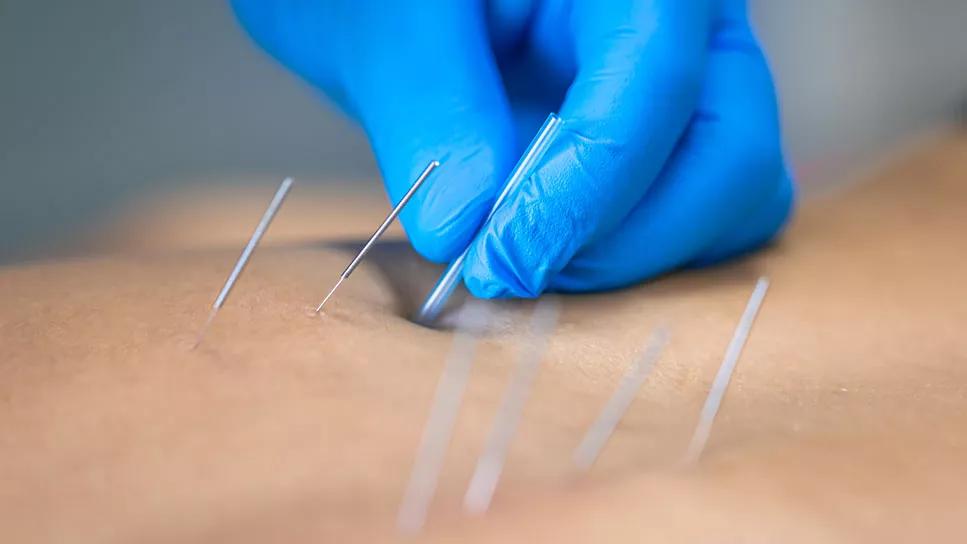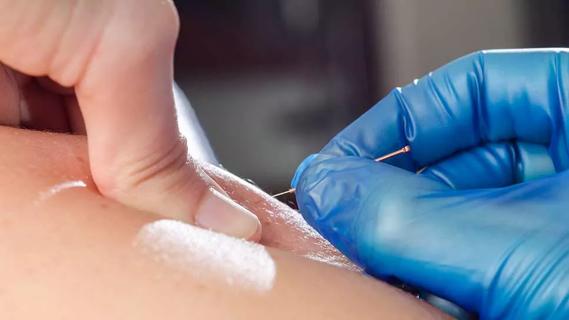Both can help reduce pain, but they’re very different in terms of origins, philosophies and practices

If you know anything about dry needling and acupuncture, it’s probably needles. More precisely, needles inserted into your skin.
Advertisement
Cleveland Clinic is a non-profit academic medical center. Advertising on our site helps support our mission. We do not endorse non-Cleveland Clinic products or services. Policy
But you might be surprised to learn that, for the most part, the similarities end there. Dry needling and acupuncture are very different practices in everything, from their origins and benefits to how many needles are used and how long a session takes.
Clinical rehabilitation manager Adam Kimberly, PT, DPT, OCS, explains the differences between dry needling and acupuncture, including what they can do for you.
Dry needling, sometimes called intramuscular stimulation, is a type of treatment for pain and mobility issues that are associated with myofascial trigger points — stiff areas in your connective (fascial) tissue that can restrict your muscle and joint movement. The needles stimulate your muscles, which causes them to twitch, or contract, and can decrease tightness, increase blood flow and reduce pain.
Acupuncture is a traditional Chinese method that may relieve pain and other symptoms of some health conditions. It’s thought to balance the flow of qi (energy) throughout your body, causing your brain to release feel-good chemicals called endorphins and stimulating your natural ability to heal.
“Dry needling approaches pain relief from a myofascial standpoint, directly addressing the muscles and connective tissue,” Dr. Kimberly clarifies, “whereas acupuncture is more focused on realigning energy and stimulating your body’s natural ability to heal.”
Advertisement
Let’s delve deeper into some of those differences.
Acupuncture is an ancient practice based in traditional Chinese medicine (TCM), while dry needling is a modern practice based in Western medicine.
The first documented use of acupuncture was in China in 100 BCE, more than 2,000 years ago, though many of today’s acupuncturists also incorporate concepts from Western medicine.
Dry needling, in comparison, is a relatively new therapy. It didn’t emerge until the 1940s, when physicians were trying to figure out how to best treat the pain that trigger points cause.
“They wanted to see which kinds of anesthetics would work best when injected into those tender spots within the muscle,” Dr. Kimberly says. “What they found was that people in the placebo group, who didn’t receive any anesthetics, found relief just from having a needle put into their trigger point and then removed.”
Today, injections with anesthetics are called trigger point injections. But dry needling, which doesn’t involve any anesthetics at all, has emerged and evolved as its own form of pain treatment.
Acupuncturists insert needles into specific acupoints throughout your body, which are located along 14 “energy-carrying channels” known as meridians. Each meridian is believed to be connected to a specific organ system, and stimulating acupoints along those meridians is thought to help restore your body’s flow of energy.
This means that your acupuncturist might insert needles into parts of your body that seem unrelated to whatever issues you’re having. If you have acupuncture to try to relieve lower back pain, for example, your acupuncturist may insert a needle or two near your ears or in your feet — areas associated with a particular meridian.
In dry needling, on the other hand, needles are inserted directly into your trigger point — the area of your muscle that’s causing you pain and limiting your movement. Your provider will feel around with their hands to figure out the right spots to insert a needle.
“We target tender tight spots within the muscle that aren’t moving as well as they could be, using the needle to go in deeper and affect that tissue,” Dr. Kimberly explains. “I almost visualize the needle as an extension of my hands, letting me get to these deeper muscles that I can't get reach through soft tissue techniques like massage.”
Dry needling and acupuncture don’t hurt in the way you might imagine. In both cases, the needles are so small that you may not even feel them going in, though you might feel a bit of a pinprick sensation.
What you’re more likely to feel, especially with dry needling, is some discomfort or soreness — especially because it directly targets trigger points, which are painful and knotted to begin with.
Advertisement
When a needle is inserted into a trigger point, you should feel your muscle twitch, which is actually a good thing.
“That tells us we're right in the right area,” Dr. Kimberly says. “There's even some research that shows that the more twitches you have, the longer lasting some of the benefits of the dry needling will be.”
You might feel a little bit sore after both dry needling and acupuncture, and you’ll want to be sure you’re drinking enough water.
“Stay hydrated can help with both soreness and mobility,” he adds.
You may leave an acupuncture appointment feeling rested, relaxed and more stress-free, but the other effects — like pain relief or any other symptom relief — usually take a few days to kick in.
With dry needling, on the other hand, you should feel some of the effects almost immediately. Your provider will likely have you test your affected muscles to see if you’ve regained any mobility, and they may assign you some moves to perform afterward.
“Stretches and exercises can help you utilize that muscle within its new range of motion to build upon those gains,” Dr. Kimberly says. “It also helps decrease some of the soreness that can happen afterward.”
Acupuncture needles may stay in for just a few minutes or as long as 20 minutes. Your acupuncturist may even leave the room while the needles are in your skin so you can rest and relax.
Advertisement
But when you have dry needling done, the needles usually don’t stay in for very long — just a few minutes. Your provider may move a needle around to try to get the muscle response they’re looking for, and they’ll stay with you throughout the process.
“We want to get the needle in, let it do its job and then remove it so you can start to test your range of motion,” Dr. Kimberly explains.
Here’s a quick look at a few other differences between the two treatments:
Advertisement
In the U.S., acupuncture is provided by licensed acupuncturists. Most states require acupuncturists to be certified by the National Certification Commission for Acupuncture and Oriental Medicine (NCCAOM).
Each U.S. state has its own laws about who can perform dry needling. In most states, dry needling is done by physical therapists, though a handful of states require dry needling to be done by acupuncturists. The American Physical Therapy Association has an infographic to help you understand the rules in your state. Physicians and physician assistants can also perform dry needling.
Acupuncture and dry needling are different practices with different purposes. Acupuncture treats musculoskeletal pain and other body systems, while dry needling treats pain and movement issues associated with myofascial trigger points.
In many cases, dry needling is suggested by a doctor who’s already treating you for some type of pain — especially because it’s usually part of a broader physical therapy treatment.
“If your physician thinks you’re a good candidate for dry needling, they may refer you to a therapist who provides it,” Dr. Kimberly says. But depending on the services available in your area, you may be able to book dry needling on your own, without a referral from a healthcare provider.
Not everyone is a good candidate for these treatments, so it’s always best to talk to a healthcare provider before you pursue either of them. But for the most part, both dry needling and acupuncture are safe, low-risk practices that may be able to help you manage your pain — and rid you of nervousness about needles!
Learn more about our editorial process.
Advertisement

As part of a larger treatment strategy, it can help decrease muscle tightness and reduce pain

Increase the size of your muscles by bulking up on protein and focusing on slow, intense movements with progressive overloading

Different types of yoga poses, meditation and breathwork may help you feel more emotionally balanced

Try seated and standing exercises to help lengthen and strengthen the muscles that support your plantar fascia

This adaptogenic herb can help your body respond to stress — but there’s not enough evidence to prove other claims about its benefits

This technique, rooted in traditional Chinese medicine, may help relieve muscle pain and lessen facial puffiness

This rigid program has a devoted following, but its intense demands also raise some concerns

There’s very little scientific evidence that this alternative medicine practice works

If you’re feeling short of breath, sleep can be tough — propping yourself up or sleeping on your side may help

If you fear the unknown or find yourself needing reassurance often, you may identify with this attachment style

If you’re looking to boost your gut health, it’s better to get fiber from whole foods